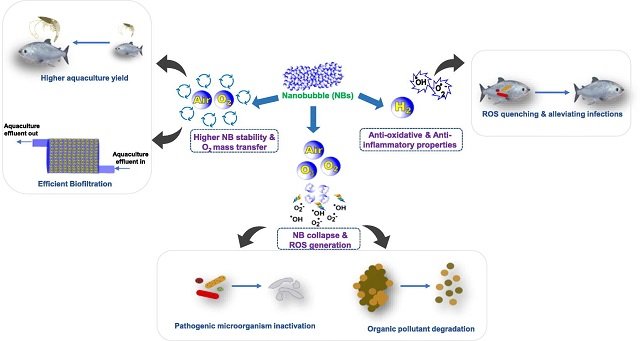
Aquaculture Recirculating Systems (RAS) have revolutionized the aquaculture industry, offering sustainable and efficient production. However, a critical component of RAS is the biofilter, responsible for removing harmful nitrogen compounds from the water. The choice of biomedia within the biofilter significantly affects its efficiency.
Biofilter performance is influenced by various factors, including the type of biomedia used and its surface area. To optimize biofilter performance, researchers from Sokoine University of Agriculture, Nyerere University of Agriculture and Technology, and the Technical University of Denmark compared four different types of biomedia: coconut shells, granulated polyurethane foam, ceramic beads, and a commercially available plastic bioelement. These media were tested in a semi-commercial RAS over 8 weeks.
The Challenge of Traditional Biomedia
Bioelements are necessary for nitrifying bacteria to colonize and convert toxic ammonia into nitrate, which is harmless to fish. The interaction between nitrifying bacteria and the biomedia’s surface is fundamental to the effectiveness of biological filtration in RAS. Biomedia with a large surface area, adequate porosity, and favorable material properties promote bacterial adhesion and biofilm formation.
Traditionally, plastic biomedia have been the industry standard. While effective, plastic biomedia raise concerns about environmental contamination due to microplastic release. Moreover, reliance on imported plastic biomedia increases costs and limits accessibility, particularly in developing countries.
Exploring Sustainable Alternatives
To address these challenges, researchers worldwide are exploring low-cost, widely available materials as potential biomedia for RAS. Materials like coconut shells, ceramic beads, and foam granules show promising potential. These materials are often locally available, cost-effective, and environmentally friendly.
Experimental Design and Methods
The experiment was conducted in a 20 m³ semi-commercial RAS, where four biofilters operated simultaneously. The biofilters were filled with similar-sized coconut shells, granulated polyurethane foam, ceramic beads, and a commercially available bioelement.
Total Ammonia Nitrogen (TAN) and nitrite conversion rates (VTR and VNR, respectively) were measured biweekly during the first 6 weeks, followed by bacterial activity assessment in week 8.
Results
According to the study published in the Journal of Water Process Engineering, the biofilter with granulated polyurethane foam achieved the highest TAN removal rate, averaging 310 ± 21 g TAN/m³/d. Biofilters with coconut shells, ceramic beads, and plastic media removed TAN at rates of 160-175 g TAN/m³/d.
Stay Always Informed
Join our communities to instantly receive the most important news, reports, and analysis from the aquaculture industry.
The polyurethane foam biofilter also achieved higher nitrite removal rates, averaging 257 ± 22.2 g NO2-N/m³/d, compared to other biomedia types.
Nitrification Kinetics
Zero-order nitrification kinetics (k0v) for VTR were estimated for each type of biomedia. Results showed that granulated polyurethane foam had the highest k0v value, averaging 539 g/m³/d, followed by ceramic beads (417 g/m³/d), coconut shells (371 g/m³/d), and plastic beads (202 g/m³/d). A similar order was observed for nitrite removal.
Bacterial Activity
After week 7, bacterial activity associated with each biofilter was evaluated using a hydrogen peroxide degradation assay. Results showed the polyurethane foam biofilter had the highest hydrogen peroxide degradation rate constant (k), with a value of 2.3 ± 0.3 h−1.
Biofilters with ceramic beads and coconut shells showed intermediate activity, with k values of 1.0 ± 0.01 h−1 and 1.4 ± 0.1 h−1, respectively. The commercial plastic biofilter had the lowest k value at 0.76 ± 0.1 h−1.
Key findings of the study can be summarized as:
- Coconut shells: While effective, they may require more frequent cleaning and replacement due to organic matter buildup.
- Ceramic beads: Provide excellent biofiltration capabilities and durability, making them a strong candidate for long-term use.
- Foam granules: Offer a large surface area for bacterial colonization, though physical stability may be a concern in high-flow environments.
- Plastic beads: Effective but raise environmental concerns and are costly.
Factors Contributing to Polyurethane Foam’s Superior Performance
- Large surface area: Its porous structure provides extensive surface area for beneficial bacteria to colonize, enhancing nitrification.
- Excellent water flow: The foam’s open structure ensures efficient water flow, maximizing contact between water and bacteria.
- Durability: Polyurethane foam is resistant to degradation, ensuring long-term biofilter performance.
- Cost-effectiveness: While the initial cost may be higher than some traditional media, its superior performance and durability can offset this over time.
Implications for the Aquaculture Industry
The findings of this study have significant implications for the aquaculture industry:
- Improved water quality: Optimizing biofilter performance enhances water quality, leading to healthier fish and reduced disease outbreaks.
- Increased productivity: Efficient nutrient removal enables higher stocking densities and increased fish production.
- Reduced environmental impact: Minimizing water use and nutrient pollution helps RAS contribute to sustainable aquaculture practices.
Conclusion
Polyurethane foam has proven to be an exceptional biomedia for RAS biofilters. Its outstanding performance in terms of nitrification and bacterial activity makes it a valuable tool for optimizing aquaculture systems. By adopting this innovative technology, the aquaculture industry can continue advancing sustainable and efficient fish production.
Contact
Lars-Flemming Pedersen
Technical University of Denmark, DTU Aqua, Section for Aquaculture, The North Sea Research Centre
DK-9850 Hirtshals, Denmark
Email: lfp@aqua.dtu.dk
Reference
Mnyoro, M. S., Munubi, R. N., Chenyambuga, S. W., & Pedersen, L. (2024). Comparison of four different types of biomedia during start-up in a recirculating aquaculture system with rainbow trout. Journal of Water Process Engineering, 68, 106549. https://doi.org/10.1016/j.jwpe.2024.106549
Editor at the digital magazine AquaHoy. He holds a degree in Aquaculture Biology from the National University of Santa (UNS) and a Master’s degree in Science and Innovation Management from the Polytechnic University of Valencia, with postgraduate diplomas in Business Innovation and Innovation Management. He possesses extensive experience in the aquaculture and fisheries sector, having led the Fisheries Innovation Unit of the National Program for Innovation in Fisheries and Aquaculture (PNIPA). He has served as a senior consultant in technology watch, an innovation project formulator and advisor, and a lecturer at UNS. He is a member of the Peruvian College of Biologists and was recognized by the World Aquaculture Society (WAS) in 2016 for his contribution to aquaculture.




